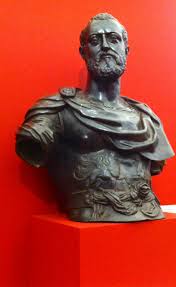By Giulia Bagni (University of Florence)
The Museo Nazionale del Bargello is hosting, ending on the 9th of July, the first monographic exhibit dedicated to the sculptor Baccio Bandinelli.
The exposition is set, as well as in the two rooms dedicated to the temporary exhibitions, as well as in Sala di Michelangelo, which is the first portion of the exhibit. Thanks to the use of red panels the curators divided the exhibition space from permanent museum space, creating a pathway that accompanies the visitor through the discovery of the artist as a sculptor and as a draftsman.
The sculptures of the first room are monumental works of art and the fact that the pathway of the exhibition is not clearly separated from the rest of the museum is important because the visitors are stimulated to make comparisons between the works of Baccio Bandinelli with those of Michelangelo, Cellini, Sansovino (with who Bandinelli was in a strong competition) and Giambologna (a follower) which are habitually on display in the room.
A unique defect is the lack of appropriate text panels that would be able to communicate fundamental information related to Baccio’s life and his activities as an artist, and the panels are also unable to frame the artist in his time and space. In fact they are present in the first room, even if they are too synthetic, but they are totally absent in the second and the third room. These rooms hold an important group of drawings and small bronze statuettes by Bandinelli (almost all of these are property of the Bargello): objects that are difficult to understand for public if they are not informed.
In the courtyard of the museum there are two videos placed to illustrated the great public monuments, sacred and the profane realized by Bandinelli, which are scattered in the squares, in the palazzos, and the churches of Florence and elsewhere. These works can’t be removed for obvious reasons, not even temporarily.
In conclusion we can say that the curators, though stimulating important research, which are collected in the voluminous catalogue, they don’t consider that the majority of the visitors do not have deep knowledge about art history and they have never heard of Baccio Bandinelli. It would be better if they had found a more effective way to communicate to the public the fundamental aspects of the Baccio Bandinelli’s works.
All of the texts in the exhibit are in both English and Italian and with the purchase of the ticket it is possible to also visit the rest of the museum.
For more information please visit the website: http://www.polomuseale.firenze.it/musei/?m=bargello
Baccio Bandinelli scultore e maestro 1493-1560
Giulia Bagni (Università di Firenze)
Il Museo Nazionale del Bargello ospita, fino al 9 di luglio, la prima mostra monografica dedicata allo scultore Baccio Bandinelli.
L’esposizione è allestita, oltre che nelle due sale riservate ad ospitare le mostre temporanee, anche nella Sala di Michelangelo che accoglie la prima sezione della rassegna. Attraverso l’uso di pannelli di colore rosso si è provveduto a separare lo “spazio della mostra” dallo “spazio del museo” creando un percorso che accompagna il visitatore alla scoperta dell’artista che oltre che scultore fu anche un ottimo disegnatore.
Le opere scultoree di questa prima sala sono tutte opere monumentali e il fatto che il percorso della mostra non sia nettamente separato da quello del museo vero e proprio è significativo poiché stimola il visitatore a stabilire confronti tra le opere di Baccio e quelle di Michelangelo, Cellini, Sansovino (con cui Bandinelli era in strenua competizione) e Giambologna (suo allievo) che si trovano abitualmente all’interno della sala.
L’unica pecca che si risconta è la mancanza di adeguati pannelli esplicativi capaci di comunicare informazioni fondamentali e significative relative alla vita del Bandinelli e alla sua attività di artista, e di inquadrarlo efficacemente nel tempo e nello spazio. Se infatti questi sono presenti nella prima sala, anche se troppo sintetici, sono del tutti assenti nella seconda e nella terza. Queste ospitano, tra le altre cose, un’importante nucleo di disegni del Bandinelli e i bronzetti da lui realizzati (quasi tutti di proprietà del Bargello): oggetti di difficile lettura per un pubblico non edotto.
Nell’ampio cortile del museo sono state installate due postazioni video che mostrano i grandi monumenti pubblici, sacri e profani realizzati da Bandinelli e che si trovano sparse nelle piazze, nei palazzi e nelle chiese di Firenze e non solo; opere che per ovvie ragioni non possono essere rimosse, neppure temporaneamente.
In conclusione si può dire che la curatori, pur avendo stimolato una serie di importanti ricerche, raccolte nel voluminoso catalogo, non ha tenuto conto che molti di coloro che visiteranno la mostra non hanno conoscenze approfondite di storia dell’arte o comunque non hanno sentito mai parlare di Baccio Bandinelli: forse sarebbe stato opportuno trovare un modo più semplice ed efficace per comunicare al pubblico gli aspetti fondamentali della sua opera.
Tutti i testi della mostra sono sia in inglese che in italiano e nel biglietto di ingresso è compresa anche la visita al resto del museo.
Per maggiori informazioni visitare il sito: http://www.polomuseale.firenze.it/musei/?m=bargello
